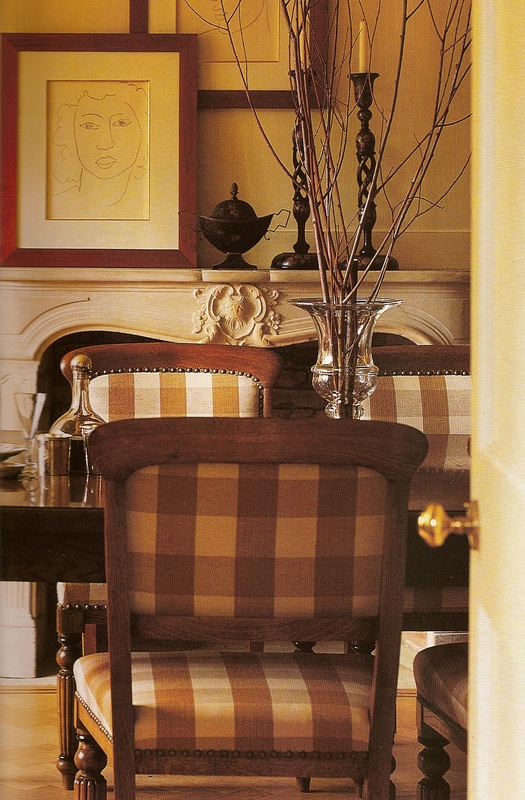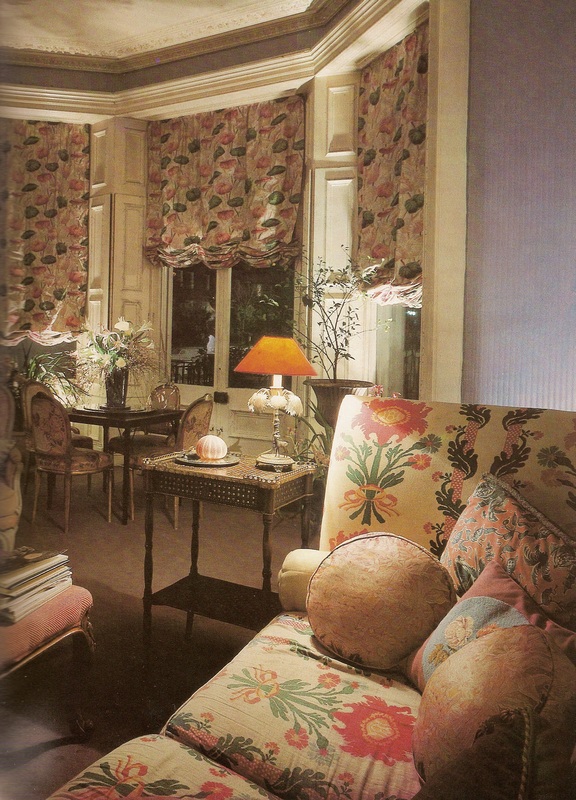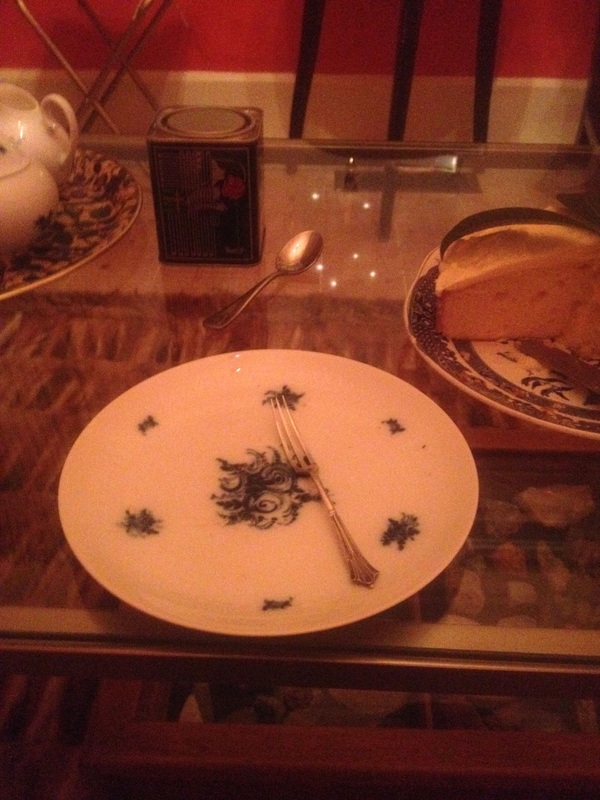 This image appeared in the World of Interiors, January 2011 issue, page 101 Ashley Hicks is the interior designer,
This image appeared in the World of Interiors, January 2011 issue, page 101 Ashley Hicks is the interior designer,
 This image appeared in the World of Interiors, January 2011 issue, page 101 Ashley Hicks is the interior designer, This image appeared in the World of Interiors, January 2011 issue, page 101 Ashley Hicks is the interior designer, David Hicks is one of my favourite British Interior designers. I love his reworking of traditional interiors. He was a master at incorporating antiques into interiors and was known for his crisp colours and the geometric prints he designed. I often pour over my copy of his book David Hicks Living with Design, published in 1979. His son, Ashley, is equally as talented. This is his bathroom in his country house. It features classic David Hicks patterns, and a trick that he often used, braids to create wall panels. I would never thought of putting this geometric onto this style chair but its a great juxtaposition. I like bathrooms that are a little different and allow you to dream while soaking in the tub. At the moment I am gathering inspiration for the reworking of our bathroom in the country and this image has some interesting ideas.
Victorian furniture seems to be out of fashion and therefore goes for bargain prices at antique auctions. I can't resist a bargain or a well made piece of furniture, but it has to be reworked to fit into todays interior. The large check fabric selected to cover these Victorian dining chairs is an unusual choice but really works giving the chairs a graphic look. Finished with close nailing details, they make a handsome addition to this stylish dining room by Roger Banks Pye of Colefax and Fowler.
Buying metres or yards of fabric for the soft furnishings of a room can be expensive, so I love to find examples of rooms where really affordable fabrics have been used. Well made soft furnishings need to be generous in fabric quantities. Full folds in curtains make all the difference and interesting trims can add that special detail. The following images show a wonderful bedroom that has used a plain cream coloured inexpensive linen for the main furnishings. The money has been splurged on the rose coloured bouillon fringing, fan edge braid and red piping detail on the bedspread. The cream colour has been worked into the scheme so it makes a strong contribution rather than just being a safe choice. The main colour is in the the painted walls. Making the trim, dado and cornice, the creamy colour ties it all together. The best thing about paint is it doesn't make much difference to the cost of a project whatever colour you choose, whereas that special shade of fabric can be costly. Notice the framed prints are also monochromatic and even the lampshade is cream. The nice little detail is the striped cotton on the arm chairs. The navy stripe adds one more colour to finish this elegant and classic room. I have been reading a really lovely blog called Aesthetic Oiseau by Daniela M. Shuffler. Daniela lives in Washington and documents her design adventures and shows pictures of her pretty little house that she and her husband have been renovating. I love to see how other people tackle renovations. Between projects Daniela post images of fabrics, rooms and accessories that inspire her, and a post about a 'quadrille' fabric caught my eye. I recognised this fabric as I had seen in a book that I own, but it was a stencilled screen. It is a very eye catching pattern. I love the centre motif and the leaf border that curls around a small checkerboard. Then the other night I was sorting my 'World of Interiors' magazines into date order ( yes, sad I know) and I naturally was having a little peek at the articles as I worked and I spied this same pattern used as upholstery fabric on a sofa. It was acknowledged with the name of 'Victor Hugo'. So I did some 'googling' and found that this fabric was produced by Pierre Frey and they have reissued it, under the name 'Le Manach Prints', and this pattern was named after Victor Hugo, famed author for Les Miserable, who is thought to have owned the original document that inspired this fabric. It seems that Victor Hugo too, was keen on interior decoration and design. He designed his own apartment in Paris and at one stage he owned a country house as well.He was very fond of chinoiserie and created very exotic richly coloured interiors. But wait there is more to this story. Years ago when Max and I developed the decorating scheme for our red sitting room I adapted the border I saw on the screen and stencilled it as a border on our pale coloured pine floor. We were minimising the sanding of the black japanned edges and decided a painted and stencilled border would frame the old pine boards well.  This screen appeared in the book, The Art of Decorative Stencilling, Adele Bishop and Cile Lord, published by Thames and Hudson, London 1976. This screen is responsible for starting my stencilling career, many years ago as this was the first time I incorporated stencilled pattern as part of a scheme. Somewhere in all the traditional rooms I do you will find a stencilled detail. I just can't resist. Do you keep cuttings or scans from magazines for inspiration? I know I do, I have been doing this since I was quite young. Cleaning out some papers in my studio the other day I came across this image. I cut it from a 1970's magazine, all those years ago, but it still resonates with me. ( Sorry about the glue used to paste it into a book). I like the strong background, that unifies all the objects in the room.The wallpaper is 'Indian' designed by William Morris, around 1870, a subtle tonal pattern that gives depth to the walls. The deep blue/grey colour which is repeated in the cornice and skirting boards is a counterpoint to the orange coloured timber of the antique table, picture frames and mantle piece. It is a warm cosy room, even thought the walls are bluey grey. The other piece that attracts me to this room is the linen covered settee in a chinoiserie floral, probably by GP & G Baker, possibly 'peony garden' or 'magnolia' famous patterns that appeared in many colour ways throughout the years. Linen upholstered sofas are classics that never go out of style and are practical and easy to live with. I also love the layering of the pictures on the walls. There is plenty to look at, but portraits seem to be the main theme. There are some interesting plates and ceramic objects. It looks like a room that has taken many trips to the auction rooms to evolve. As this cutting is so old I cannot reference it in any way so if anybody recognises it please let me know. Also: Morris and Co in the U.K. still have this pattern, but in different colour ways and GP & J Baker fabrics still have similar classic floral linen prints available too.
One of the most exciting ways to shop is visiting the local auction rooms bidding for little treasures. I like to go to Leonard Joel, in Prahran. We make an adventure out of this. Joels publish the catalogue the day before online and I check out possible items and estimates. I make a list. We go and have a look, and usually something else catches my eye. Next day we go to the auction and spend a few hours watching, waiting and bidding. The furniture auction starts at 10am and the decorative items at 12.00 sometimes we go and have lunch or coffee between lots. There are antique dealers and many interesting characters who regularly attend adding great theatrics to the day. This week I came home with some lovely books with leather bindings, an 18th century chinoiserie plate, two Japanese" Imari" patterned plates, a set of fruit knives and forks and a papier mache crumb tray and brush. You can see it is quite a stash, I only went for one plate! Now we get to spend time finding places to put all these bits and we can spend hours pouring over the books.
Winter in Melbourne is a good excuse to break out the cashmere cardigans and pleated silk scarves. As I continue to post you will find that Mariano Fortuny is one of my design heroes. This is a little preview of another web page I have added: Faux Fortuny Pleats. When I am not designing or sourcing items for interiors I am sewing clothes or making things to enhance our home or presents for friends. Yes it is still cold but all that rain has to be good for our water catchments if not for my renovations. So to make the most of having time to snuggle down this weekend I decided we might christen a tea set that I bought a few years ago and have been waiting for a special occasion. So I baked a cake, donned the cashmere and we settled down to enjoy a cup of tea in our lacquer red coloured sitting room, where just the colour warms you up. We cleared the brass and glass coffee table of its usual 'tablescape' and laid out our Rosenthal tea set. I placed it on an old 'Liberty of London tray'. Two generously sized tea bowls, and saucers, two side plates matching milk jug and sugar bowl and a grand teapot. The design originates from the 1780s and is the classic blue and white hand painted floral pattern. You can see from the photos it is very pretty and very classic. I served black tea that we bought in Glasgow at the 'House for an Art Lover' in its Charles Rennie Mackintosh tin, which has a 'chinoiserie feel' being black with some little red accents. When tea was first introduced to Europe it was very expensive and the caddies where the tea was stored were items of beauty and kept on display in the sitting room rather than the kitchen. I trimmed the cake with bay leaves for decoration and we broke out the silver teaspoons and cake forks and played ladies for a couple of hours, basking in the warm reflection from the red walls. This room we designed to be used as a winter sitting room or a dramatic night reception room. |
AuthorHi I am Elizabeth an interior designer who lives in Melbourne, Australia in a little Californian Bungalow cottage with my partner, Max, who is also an Interior Designer, and our beloved furry children, Doris & Ernest. I believe that design can make our lives more rewarding and productive. I love, architecture and design theory but my everyday passion is fabrics and decoration, as I don't think we should get too serious but have fun with our homes and enjoy the process of creating our own environments. I am interested in classic cars, and collect Georgian and Mid Century furniture. Archives
July 2018
Categories
All
|
















 RSS Feed
RSS Feed

